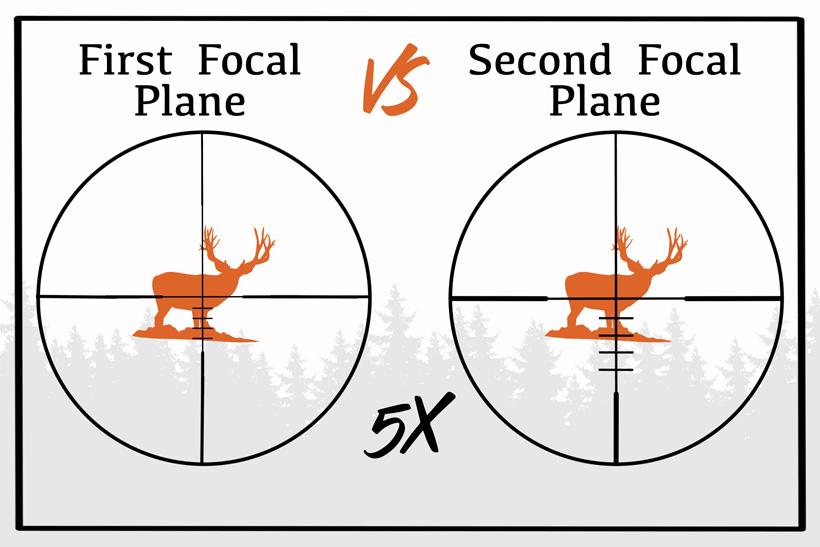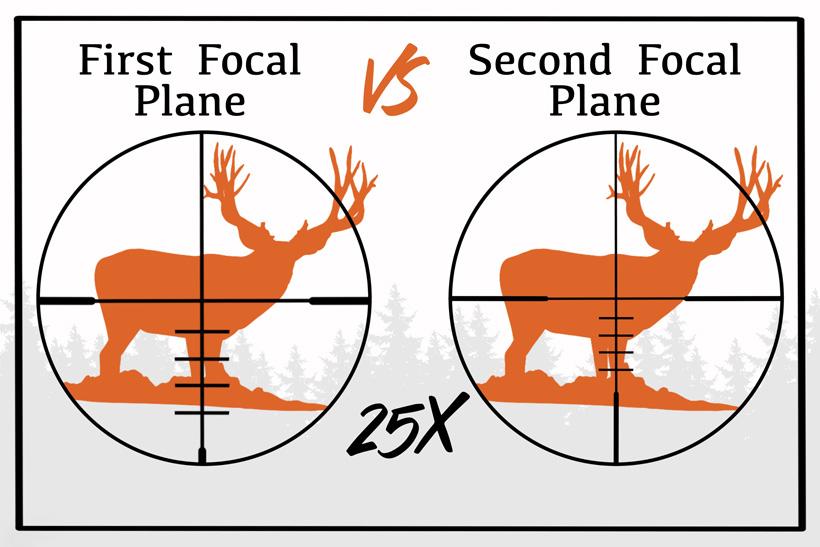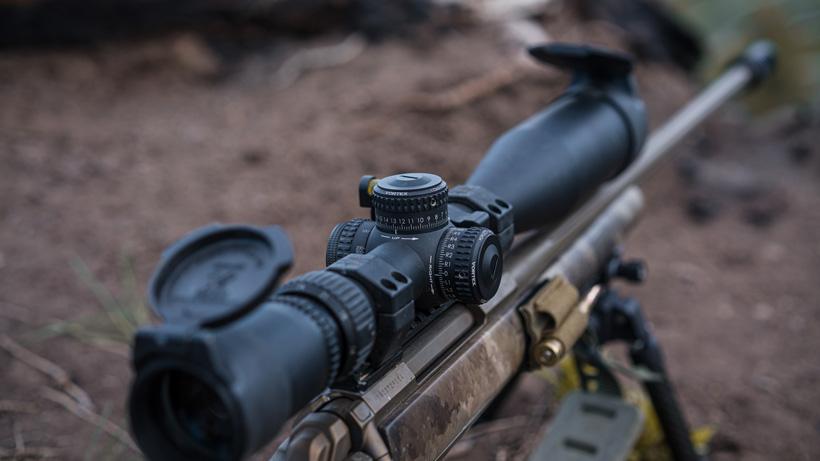




Graphics created by Dave Barnett


Using a Vortex Razor HD AMG 6-25x50 on one of my favorite hunting rifles.

There’s a ton of options out there nowadays when it comes to selecting a riflescope. You have MOA, MIL, various magnifications, different objectives, tube sizes and a ton more. But one of the hardest decisions seems to be around what focal plane to select.
In the past, I’ve always used second focal plane riflescopes for hunting. They have worked great for me on my rifles and I've taken a ton of animals with them, but a few years ago I wanted to try something new so I switched to a first focal plane system. Mainly this switch happened because I wanted to help people out with their decisions so I could better explain what option might work best for them and my opinion on them. They both work great, but I wanted to have real-world experience behind each design.
For starters, we need to define a first focal plane riflescope. This is probably the scope version that most people in hunting are a little unfamiliar with. On a first focal plane riflescope, the reticle grows as the image gets bigger when increasing magnification and it does so at the same rate. And as you decrease magnification, the reticle also shrinks as the image gets smaller. This is all because the reticle is located in front of the magnifying lens assembly in the scope.
A first focal plane riflescope also means you can always use those hash marks on the reticle for any elevation holdover or windage no matter what magnification you are on. This can be great if you don't have time to dial in your turret in a hunting situation and you need to use the hashmarks.
As I stated earlier, the first focal plane riflescope was new to me a few years ago. And since the switch, I don’t know if I’ll ever go back.
The only downside I see is when you're at super low magnification the reticle is almost too small to see, especially if you're in thick timber or hunting in low light. I really notice this on my Razor HD Gen II 4.5-27x56 riflescope that is in a first focal plane setup when I go down to 4.5 power. To deal with this, if you’re hunting in a state that allows an illuminated reticle to hunt with, the illumination could allow you to make use of low power in the thick timber on a first focal plane setup. But for the most part, I don't see this as a hindrance at all since 95% of the time I'm not hunting in thick timber at lower power. But it's just something you should think about if you're going to purchase a new riflescope.
Possibly one other downside is if you’re trying to shoot at a very small target in practice at a longer distance because your reticle may block the target due to it getting larger at max power. I've seen this happen when I've been practicing out in the desert while aiming at something really small and and trying to be very precise.
One of the biggest benefits of a first focal plane riflescope is if you need to quickly make a shot and need to use the elevation or windage lines in the scope, this is when a first focal plane riflescope will shine. For the most part, since I’m a hunter first and not a competition precision rifle shooter, these situations are a little rare for a hunter to need to quickly use elevation holdover marks, but it’s nice to have that feature if you’re ever in this situation on the buck of a lifetime.
Cost is another consideration. Usually, a first focal plane riflescope is a little more expensive than a second focal plane riflescope.
Second focal plane riflescope is what everyone is most likely used to in hunting. The biggest thing you’ll notice on a second focal plane riflescope is the reticle stays the same size, and the target grows as you increase the magnification. This is due to the reticle being located behind the magnifying lens.
A second focal plane riflescope seems to be nicer to aim through because you have a finer aiming point due to the reticle staying small as you hit full magnification which is great when practicing long-range shots as your reticle isn’t covering up the spot you are trying to aim at.
The one main downside of a second focal plane riflescope is when dealing with adjusting the magnification to anything other than max power and using the reticle for any holdover or windage when taking a shot. If your second focal plane riflescope is set for max power, that means that the holdover lines in the reticle are only dialed in at that one magnification and will not be at the correct yardages if you drop to a lower magnification. So if you drop to a lower magnification and use the holdover lines, it won't be to scale and you'll miss the target. So to fix this, if you want to use any of the hashmarks, you must remember that it is only truly calibrated at max magnification.
Keep in mind... that no matter what, in a second focal plane riflescope you can always dial your turrets and use the center of the reticle no matter the magnification you are on. This change in impact discussed above is when using any of the hashmarks outside of the center of the reticle when you are on anything but max power.
This is why whenever I’m hunting, I’ll always shoot at an animal at the highest magnification. Second focal plane riflescopes have worked wonders for a ton of hunters throughout the years. Again, remember that dialing up on the turret on a second focal plane riflescope works perfectly if you just aim at the center dot of the reticle no matter what magnification you are on.
In summary, if you use a second focal plane scope and you want to use the holdover hashmarks, know it will be only valid for one magnification.
If I’m going to need to use the windage or elevation marks in my riflescope, 99.99% of the time I’m going to be at full magnification which means everything will be accurate in a second focal plane setup.
The way I'd explain my reasoning for a second focal plane scope for a lot of years is this; pretty much any shot over 300 yards I'm going to be at full magnification. So at that point, it really doesn’t matter what riflescope plane I’m using since I will be at full magnification and would be able to use the hashmarks on a second focal plane if needed, and I would also have the same benefits of a first focal.
Below is a quick series of graphics to help showcase some of the differences side by side at low magnification and high magnification.
Once again, on the first focal plane riflescope on the 25x power example, you'll notice that the reticle grows as the image gets bigger due to adding magnification and it does so at the same rate. And on the second focal plane image, the reticle stays the same size as you increase the magnification.
Using a Vortex Razor HD AMG 6-25x50 on one of my favorite hunting rifles.
One last thing I should mention, if you have a riflescope with turrets in either first or second focal plane, it does not matter what magnification you are if you aim using the center of the reticle. You will still make an impact with the correct distance dialed in the turret. You could be at low magnification on a second focal plane riflescope and dial in for a shot with the turret and make an impact. Then you could dial in for a longer shot using the turret and crank the magnification all the way up and still impact the target aiming at the center.
At this point after using both for a long time now in hunting and practice, I’m still leaning toward first focal plane riflescopes. My dad, who also is very into rifles and long range shooting for practice and hunting, doesn’t like second focal plane scopes at all anymore either. Then if you'd ask my brother who I shoot with a ton... he prefers second focal plane on his hunting setup.
So at the end of the day, both focal planes will absolutely work wonders for hunting, it just comes down to what your eyes might prefer and your use case.
If you have the ability, find a friend who has a different scope than you do and really look at a first focal plane and second focal plane side by side. This is going to be the easiest way to determine what style you prefer.
Don't forget, if you ever have any questions about anything optics, you can reach out to our Optics Manager Cody Nelson. He is a wealth of knowledge and a person you should take advantage of when deciding what optics to purchase. Cody can be reached at optics@gohunt.com or call him at (702) 847-8747 | Ext. 2.